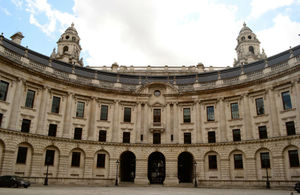Museums given last chance to save rare Islamic rock crystal ewer
Culture Minister Ed Vaizey has placed a temporary export bar on a rare medieval Islamic ewer carved from a single block of rock crystal.

Culture Minister Ed Vaizey has placed a temporary export bar on a rare medieval Islamic ewer carved from a single block of rock crystal. The ewer, or jug, is richly carved and has exquisite gold mounts made in France in the nineteenth century. This will provide a last chance to raise the money to keep this beautifully crafted work of art in the United Kingdom.
The Minister’s ruling follows a recommendation by the Reviewing Committee on the Export of Works of Art and Objects of Cultural Interest, administered by the Museums, Libraries and Archives Council (MLA). The Committee recommended that the export decision be deferred on the grounds that the ewer is of outstanding aesthetic importance and of outstanding significance for the study of Islamic art.
The ewer is one of only 9 other complete or nearly-complete Islamic rock crystal ewers known to have survived anywhere in the world.
It was made by an anonymous craftsman, almost certainly in Cairo some time between 970 and 1070 AD, during the Fatimid period (909-1171 AD). It was carved from a single flawless block of rock crystal, hollowed out to a thickness of only one or two millimetres, and stands 30 cm high. The design shows a stylised cheetah with a chain around its neck, a symbolic attribute of the Fatimid Caliphs as cheetahs were used for the courtly pastime of hunting. The ewer was a luxury item made for the upper stratum of Fatimid society, which at its height was the richest state in the Mediterranean.
Enamelled gold mounts forming the top, base and handle of the ewer were added in the mid-nineteenth century by Jean-Valentin Morel (1794-1860), a leading French lapidary and jeweller. These mounts enhance the ewer’s interest, making it important for illustrating artistic taste in nineteenth-century Europe as well as in the Fatimid court.
Lord Inglewood, Chairman of the Reviewing Committee, said: “The ewer is a wonderful object which represents an outstanding level of artistic achievement. Its rarity makes it highly significant for the study of the art of two distinct but connected cultures.”
The decision on the export licence application for the ewer will be deferred for a period ending on 27th June 2010 inclusive. This period may be extended until 27th October 2010 inclusive if a serious intention to raise funds with a view to making an offer to purchase the ewer at the fair market price of £20,000,000 is expressed.
Anyone interested in making an offer to purchase the ewer should contact the owner’s agent through:
The Secretary
The Reviewing Committee on the Export of Works of Art and Objects of Cultural Interest
Museums, Libraries and Archives Council,
Grosvenor House
14 Bennetts Hill
Birmingham B2 5RS
Telephone 0121 345 7428
Notes to editors
-
For all media enquiries please contact Sunita Sharma, Senior Media Relations Adviser, Museums, Libraries and Archives Council, on 020 7273 8299, email: sunita.sharma@mla.gov.uk.
-
For enquiries on the operation of and casework arising from the work of the Reviewing Committee on the Export of Works of Art and Objects of Cultural Interest (RCEWA) please contact Sean Farran, RCEWA Secretary, on 0121 345 7428, email: sean.farran@mla.gov.uk.
-
The Reviewing Committee on the Export of Works of Art and Objects of Cultural Interest is an independent body, serviced by MLA, which advises the Secretary of State for Culture, Media and Sport on whether a cultural object intended for export is of national importance under specified criteria. Where the Committee finds that an object meets one or more of the criteria, it will normally recommend that the decision on the export licence application should be deferred for a specified period. An offer may then be made from within the United Kingdom at or above the fair market price.
-
The details of the ewer are:
* Carved from a single block of rock crystal, the body of tapering slightly rounded conical form on short central spreading foot, each side carved in relief with a seated cheetah held on a link chain, together flanking a central panel of interlaced arabesques with palmette terminals, a meandering band of leafy vine forming a border around the composition, the back with the base of a handle drilled and carved with paired leaves.
* Almost certainly made in Cairo, Egypt, some time between the 970s and the 1060s; Mounted in enamelled gold on base, handle and cover, the mounts added in 1854 by Jean-Valentin Morel (1794-1860) at Sevres in France; 30.7 cm high.
Press Enquiries: 020 7211 2210
Out of hours telephone pager no: 07699 751153
Public Enquiries: 020 7211 6000